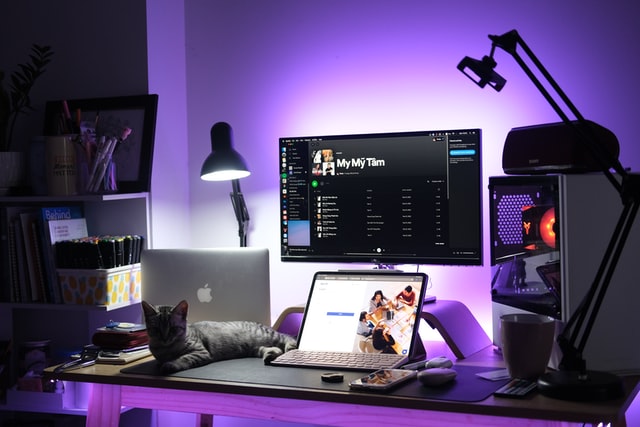When a lot of creatives read this blog title I imagine a combination of fear, disgust and anger will be running through their veins at the suggestion of such a thing but in all honesty, even though I am a designer and creator of branding there is a place to using templates. In this blog post, I discuss several places when and where it is okay to use a template for design of a new digital presence.
1) Time is short

The problem with a lot of creative products is that they seem to come out of nowhere as if they have been around since the dawn of time when in fact great design, like anything worthwhile, takes time and research.
Unfortunately, not every client has the time or patience to wait a few months for their website to be developed and so a template may be required to speed up the process. A template can cut your workload by having half of the design written for you already.
This doesn’t mean that your designer is not going to alter the template further to reflect your brand but it does shave off a lot of time if the structure of the design is already in place.
For example, a lot of designers may use elements of different web templates to develop something that their client wants or has seen on another website and if that feature is already in place on another web template it makes logical sense to use the template that has the functionality that the user is requiring.
2) Client budget
Time is money and in the designer’s world, it really is. A lot of designers charge by the hour and if they have to code everything from scratch, design all the graphics, develop a brand story and all the other elements that go with the design then it starts to add up to be quite a large amount of money.
If you are working with a professional designer then you are going to expect to pay at least £20/$30 per hour ( remember designers need to make a living too! ) it could easily work out to be an expensive project, whereas if you use a template it could cost slightly less due to it taking less time to construct.
As a designer, I don’t think there is any shame in using a template when the budget or time is tight as it’s about providing your client with what they need, just make sure you make it clear you are going to be working from a template for a basis.
3) Template for design have code that you need
Why rework the wheel when the wheel is already built?
The same goes for code, if there is functionality such as a javascript gallery that you think your client requires for their online presence then it is worth using it so that both you and your client benefit from a faster and more efficient design process.
Just make sure it definitely works on all browsers and also consider whether all people will be able to see/use the feature as usability is very important. Remember, although we design for our customers we are also designing for our customer’s customers.
4) Specialist skill is in one area


When you hire a freelancer they may be an expert at graphics or coding or branding, if you are lucky, they will be very good at everything but it is without hesitation that I can say that they will be best at one skill over the others.
Sometimes to help in developing something extra special using templates of their weaker skill can help in developing something that the client requires.
5) Learn how to create specific elements through others
Another benefit of using templates from a designer viewpoint is that something you may not have done or seen before will be in some templates and you can then dismantle it and study how it is constructed benefiting you by gaining the knowledge of a new feature, layout or graphic design.
The problem with using templates
Although templates are useful tools for both clients and designers they can also have their problems and setbacks.
1 )Restricting design process
When you develop a brand you want the WHOLE experience to be designed so that the user experience of it gives the emotional response the designer wants. A template still takes time to select as you need to make sure the right message will be portrayed to the end-user.
2 ) Overused
Great templates are loved by lots of people and so thousands of the same templates can be used by designers across the globe which can make you less unique.
What’s worse is that if you don’t change much of the template to reflect the brand concept then there is a chance your user will have experienced a website very similar to yours, if not identical which will damage your brand image.
A good designer will change the template so it’s almost visually recognisable as a template and reflects your brand to perfection so just make sure that when your website is in creation that it shows individuality.
3 ) Bad coding practice
Not all templates created are created equal, some have bad coding practices, are overloaded with code, lack browser compatibility and more. Check that whatever template you are considering using has functionality and by god, please make sure it is responsive ( viewable on all devices ).
4 ) Fitting the brand
As mentioned earlier the template has to be tweaked and pulled till it reflects the brand and the marketing messages that your company requires, check that you discuss the user goals of your website with your designer, what is it you are trying to achieve?
5 ) Understanding the template for design
Sometimes templates can be a little confusing to configure and modify for designers depending on what it is you are using and if it is a CMS (content management system) website then your client may to find it hard to configure it. It is hugely important that your client is able to understand the backend of the site so they can edit and modify it with ease.
As a designer one has to consider how easy it would be to use something for someone who doesn’t have much knowledge of the web but still wants control of their own online presence.
There are plenty of things to consider when choosing to use a template for design but primarily whether it is suitable for the client.
Our mission as a designer is to find the best solution for the person we are working with and if time or a limited budget is important then using a template can help the client reach their desired goal without harming the designer’s livelihood. Don’t be afraid to suggest using templates. If you need a bespoke site or a template that we’ve created we can help you, visit our website service page for more information on our services.
If you want to buy your own template and try to build a site yourself we recommend themeforest.net and if you need support building it feel free to contact us.

